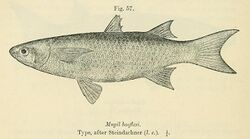Biology:Grooved mullet
| Grooved mullet | |
|---|---|

| |
| Scientific classification | |
| Domain: | Eukaryota |
| Kingdom: | Animalia |
| Phylum: | Chordata |
| Class: | Actinopterygii |
| Order: | Mugiliformes |
| Family: | Mugilidae |
| Genus: | Chelon |
| Species: | C. dumerili
|
| Binomial name | |
| Chelon dumerili (Steindachner, 1870)[2]
| |
| Synonyms[3] | |
| |
The grooved mullet (Chelon dumerili) is a species of ray-finned fish, a grey mullet from the family Mugilidae. It is found in the coastal waters of the eastern Atlantic Ocean off the western coast of Africa, as far north as Mauritania, and into the western Indian Ocean.
Description
The grooved mullet has a total of five spines in its dorsal fins and eight or nine soft rays, the anal fin has three spines and eight or nine soft rays. The anal fin and the lower lobe of the caudal fin are coloured whitish or greyish. The body is coated in ctenoid scales apart from the scales in front of the anterior dorsal fin which are cycloid, extending to the front nostril or slightly beyond it. Its scales are small and numerous and there are 33–41 scales in a longitudinal series, not including those on the caudal peduncle, and 11–14 scale rows between pelvic and anterior dorsal fin.[3] It grows up to 40 cm (16 in) in length.[4]
Distribution
The grooved mullet is found on the Atlantic coast of Africa from Mauritania in the north to the mouth of the Cunene River in Namibia. An allopatric population is found in the south-western Indian Ocean from False Bay in the Western Cape to southern Mozambique.[5]
Habitat and ecology
The grooved mullet is found in brackish and marine waters in estuaries and coastal shallows. It is a very adaptable species and has been recorded in both freshwater and hypersaline environments.[1] Spawning occurs offshore and the fry move inshore while feeding on zooplankton. The adults sift food such as organic detritus, blue-green algae, diatoms, gastropods, and foraminifera from the substrate, usually coarse sand.[1]
Uses
The grooved mullet is fished for by commercial fisheries and mullets are used in aquaculture in Africa but it is not known if this involves this species. More research is needed to determine the conservation status of the grooved mullet[1] and of its taxonomy.[5]
Taxonomy and naming
The two populations of grooved mullet are allopatric, and genetic sampling showed that haplotypes from West Africa were very different from those sampled in South Africa and that the two populations should be treated as sister species.[6] The Atlantic species would retain the name Chelon dumerili as the type locality is Saint-Louis, Senegal while the name Chelon natalensis (Castelnau, 1861) or C. canaliculatus (J.L.B. Smith, 1935) have been suggested for the Indian Ocean taxon, although pending taxonomic revision this taxon has been designated as Chelon Species B.[5]
The specific name honours the France ichthyologist and herpetologist Auguste Duméril (1812–1870) of the Muséum national d'histoire naturelle who lent Franz Steindachner specimens of fishes collected in Senegal.[7]
References
- ↑ 1.0 1.1 1.2 1.3 Camara, K.; Djiman, R.; Nunoo, F. et al. (2015). "Chelon dumerili". The IUCN Red List of Threatened Species 2015: e.T183171A1731060. doi:10.2305/IUCN.UK.2015-4.RLTS.T183171A1731060.en.
- ↑ Eschmeyer, William N.; Fricke, Ron; van der Laan, Richard, eds. "Mugil dumerili". California Academy of Sciences. http://researcharchive.calacademy.org/research/ichthyology/catalog/fishcatget.asp?spid=16952.
- ↑ 3.0 3.1 Froese, Rainer and Pauly, Daniel, eds. (2018). "Chelon dumerili" in FishBase. June 2018 version.
- ↑ G. Bianch, ed (1999). Field Guide to the Living Marine Resources of Namibia. Food and Agriculture Organization. p. 179. ISBN 978-9251043455. https://books.google.com/books?id=61fK4UG6xbwC&dq=grooved+mullet&pg=PA179.
- ↑ 5.0 5.1 5.2 Jean-Dominique Durand; Alan K. Whitfield (2015). "Biogeography and Distribution of Mugilidae in the Western, Central and Southern Regions of Africa". Biology, Ecology and Culture of Grey Mullets (Mugilidae). CRC Press. p. 107. ISBN 978-1482252132.
- ↑ Durand, J.-D.; Shen, K.-N.; Chen, W.-J.; Jamandre, B.-W.; Blel, H. et al. (2012). "Systematics of the grey mullets (Teleostei: Mugiliformes: Mugilidae): molecular phylogenetic evidence challenges two centuries of morphology-based taxonomy". Molecular Phylogenetics and Evolution 64 (1): 73–92. doi:10.1016/j.ympev.2012.03.006. PMID 22445821. http://hal.ird.fr/ird-00695484/document.
- ↑ "Mugiliformes". The ETYFish Project Fish Name Etymology Database. Christopher Scharpf and Kenneth J. Lazara. 4 June 2018. http://www.etyfish.org/mugiliformes/. Retrieved 26 October 2018.
Wikidata ☰ {{{from}}} entry
 |


